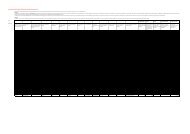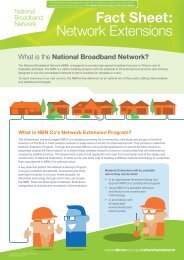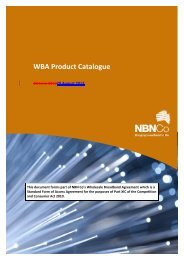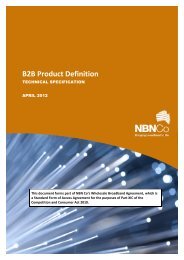NBN Co Network Design Rules
NBN Co Network Design Rules
NBN Co Network Design Rules
Create successful ePaper yourself
Turn your PDF publications into a flip-book with our unique Google optimized e-Paper software.
<strong>NBN</strong> <strong>Co</strong> <strong>Network</strong> <strong>Design</strong> <strong>Rules</strong><br />
allows for simple power related alarms to be forwarded from the UPS unit to the GPON NTD. The<br />
UPS can be installed with or without a battery, allowing an Access Seeker or end-user to provide a<br />
battery at a later date, and perform maintenance of the battery facility without requiring <strong>NBN</strong> <strong>Co</strong><br />
involvement. When there is no battery installed, the UPS operates like a regular AC to DC power<br />
supply. Both the AC to DC power supply and UPS must be installed indoors. When installed with an<br />
Outdoor GPON NTD, the power cabling must extend within the premises to the power supply or<br />
UPS.<br />
1.1.2. PON<br />
The <strong>NBN</strong> <strong>Co</strong> Passive Optical <strong>Network</strong> is required to provide connectivity in the form of a Fibre to the<br />
Premises (FTTP) network for a minimum of 90% of Australian premises.<br />
The passive network component of a fixed network build comprises a significant part of the overall<br />
FTTP deployment. It is disruptive and expensive to augment or modify so it is important that the<br />
architecture, planning, design, and installation accommodates the long term needs and future<br />
growth and capacity. It is <strong>NBN</strong> <strong>Co</strong>’s aspiration that these facilities will be suitable not only for the<br />
<strong>NBN</strong>’s initial technology choice, but for fixed access technologies developed in the future, whatever<br />
they may be.<br />
In order to provide a functional and operational network a high degree of uniformity of the passive<br />
infrastructure is desirable. Uniformity of design and construction facilitates education and training,<br />
the availability of competent staff, and economies of scale and efficiencies in the supply industry in<br />
general. Regionalised or localised variations in design or construction practices will be minimised<br />
where practical as these differences may disadvantage the affected communities due to the<br />
increased costs and complexity of managing variations in technical and operational processes.<br />
The <strong>NBN</strong> <strong>Co</strong> Passive Fibre <strong>Network</strong> includes the Distribution Fibre <strong>Network</strong> (DFN), the Local Fibre<br />
<strong>Network</strong> (LFN) and Premises Fibre <strong>Network</strong>s (PFN). The DFN and LFN are connected with a Fibre<br />
Distribution Hub. PFNs provide the connectivity from the LFN to the Fibre Wall Outlet (FWO).<br />
The common denominator of this network is the actual physical fibre strands. <strong>NBN</strong> <strong>Co</strong> has selected<br />
ribbon fibre technologies due to the benefits of using ribbon and the high level cost and labour<br />
savings associated with the use of this technology.<br />
5
















